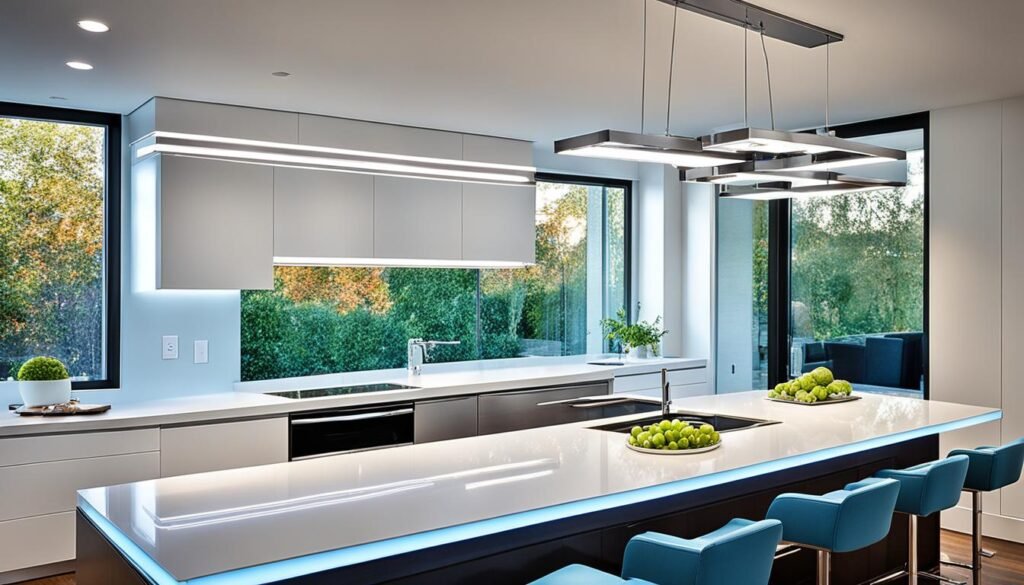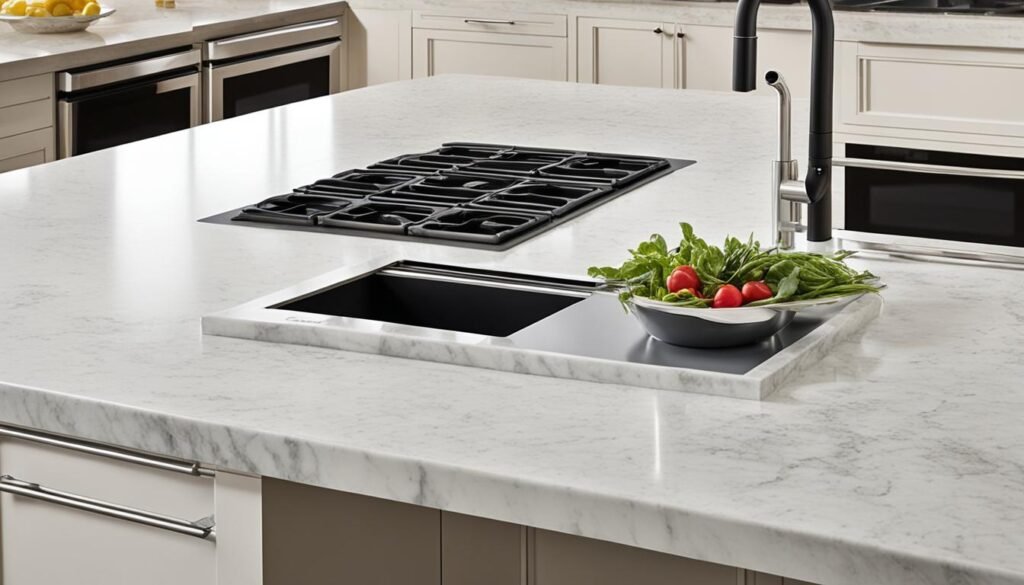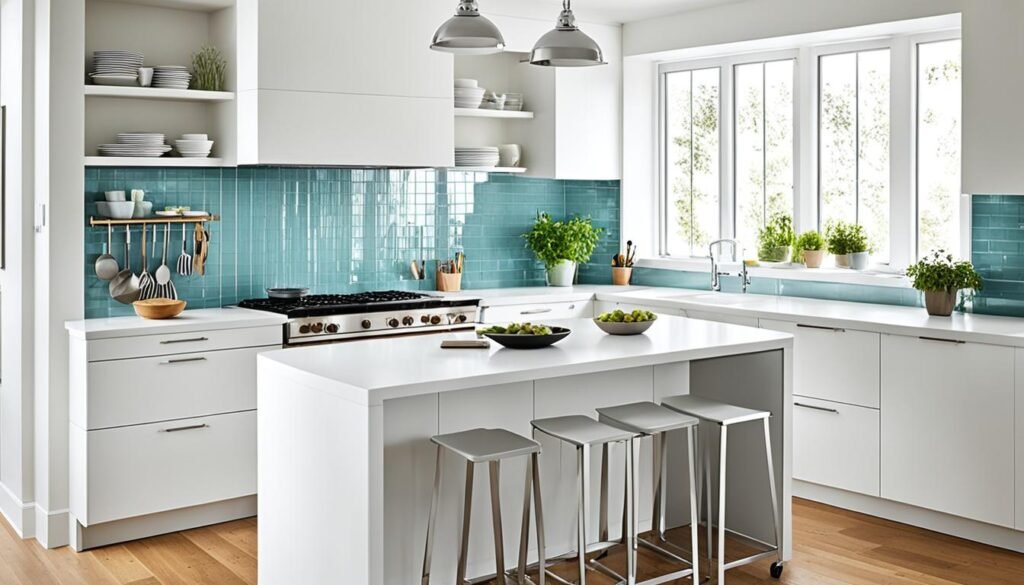A kitchen island is a versatile addition to any kitchen, providing extra storage, countertop space, and seating. When choosing the right kitchen island, there are several factors to consider. From the size and layout of your kitchen to the materials and functionality of the island, this guide will help you make an informed decision.
- Consider the size and layout of your kitchen.
- Take into account the available floor, counter, and storage space.
- Think about whether you want seating around the island.
- Choose the right materials for durability and aesthetic appeal.
- Ensure adequate clearances and consider the work triangle.
- Incorporate seating and storage options in your island.
- Plan for appliances and electrical needs.
- Determine the right shape that complements your kitchen.
- Consider portable and mobile options for flexibility.
- Provide proper lighting for functionality and style.
By considering these factors, you can find the perfect kitchen island that meets your needs and enhances the functionality and style of your space.
Factors to Consider When Choosing a Kitchen Island
When selecting a kitchen island, it’s crucial to factor in the size of your kitchen and the available space. Consider the floor space, counter space, and storage space you have to work with. Additionally, think about the layout of your kitchen and how the island will fit into the overall design.
If you’re working with a small kitchen, opt for an island that doesn’t overcrowd the space. Make sure to account for the necessary seating area if you want to have stools around the island. Take into consideration how much space you’ll need for comfortable movement around the island, as this will help determine the size and shape that work best for your kitchen.
Incorporate functionality into your decision-making process by considering the storage needs of your kitchen. If you require additional cabinet space, choose an island that provides ample storage options. By taking into account the size and layout of your kitchen, as well as the available floor and counter space, you’ll be able to select a well-proportioned island that enhances the functionality and design of your kitchen.
Important Factors to Consider:
- Size of your kitchen and available floor and counter space
- Layout of your kitchen and how the island fits into the design
- Seating area and the space needed around the island
- Storage needs and available cabinet space
Choosing the right size and shape of your kitchen island is essential to ensure optimal functionality and design integration. By carefully considering these factors, you’ll be able to create a kitchen space that is both visually appealing and highly functional.
In the next section, we will explore the best practices for choosing the ideal size for your kitchen island, taking into account various factors such as the size of your cabinets, the layout of your kitchen, and the space needed for seating and other activities around the island.
Best Practices for Choosing a Kitchen Island Size
When it comes to choosing the right size for your kitchen island, it’s essential to consider the available space and how you intend to use the island. Whether you’re adding a kitchen island to your existing kitchen or designing a new one, finding the perfect size is crucial for optimal functionality and aesthetics.
If you have a small kitchen, it’s important to choose a kitchen island size that doesn’t overwhelm the space. A smaller island will prevent overcrowding and ensure that you have enough room to move around comfortably. Consider a compact design that incorporates features like storage cabinets and a countertop for food preparation, making the most of the available space.
On the other hand, if you have a large kitchen, you have more flexibility in choosing a kitchen island size. A larger island can become a focal point and provide additional workspace, storage, and seating. Consider a spacious design that allows for ample countertop area, island cabinets, and even a seating area for casual dining or entertaining guests.
Determining the best size for your kitchen island also involves considering the size and layout of your cabinets. Ensure that your island complements the existing cabinetry, both in terms of size and style. This will create a cohesive and harmonious look in your kitchen.
Additionally, take into account the space you need around the island for comfortable seating and other activities. Allow enough room for individuals to move freely, especially if you plan to have bar stools or chairs around the island. This will ensure a seamless flow in your kitchen and prevent any congestion.
By considering the size of your kitchen, the available space, the layout, and the specific functions you require from your island, you can determine the best size for your kitchen island. Remember that the right kitchen island size will not only enhance the aesthetics of your kitchen but also provide you with the functionality and efficiency you desire.
Choosing the Right Materials for Your Kitchen Island
The materials you choose for your kitchen island can significantly impact both its appearance and functionality. Consider the type of kitchen island that best suits your needs, such as a fixed island or a mobile or portable one.
When it comes to countertop materials, natural stones like marble and soapstone offer durability and a timeless look. Engineered quartz countertops are another popular option, offering easy maintenance and a wide range of design choices. If you prefer a warm and inviting feel, wood countertops can add that touch of warmth to your kitchen. However, keep in mind that wood countertops may require regular sealing to prevent water damage.
Aside from the countertop material, the width and shape of the island should also be considered. The size of your average kitchen and kitchen island will determine how much space you need for the island in terms of its width. Furthermore, the shape of the island should be determined based on your needs and the available space in your kitchen.
Overall, choosing the right materials for your kitchen island involves considering your style preferences, maintenance requirements, and the available space in your kitchen.
| Type of Kitchen Island | Pros | Cons |
|---|---|---|
| Natural Stone (e.g., marble, soapstone) | Durable and timeless look | May require regular sealing |
| Engineered Quartz | Easy maintenance, wide range of design options | Relatively expensive |
| Wood | Warm and inviting, adds character | Requires regular sealing |
Considering Clearances and Work Triangle
When designing your kitchen island, it’s important to take into account the clearances around the island and the work triangle in your kitchen. These considerations ensure that your island doesn’t obstruct movement and maximizes functionality in your kitchen space.
Clearances around the kitchen island are essential for easy movement and creating comfortable seating areas. It’s crucial to determine the appropriate space required for walking around the island, allowing you and your family to navigate the kitchen without any obstacles.
The work triangle is a key concept in kitchen design, which includes the distance between the cooking appliance, refrigerator, and sink. This triangular layout ensures an efficient workflow in the kitchen and easy access to essential elements when preparing meals.
“The clearance around the kitchen island and the work triangle are vital aspects to consider when designing your kitchen.”
Depending on the size and layout of your kitchen, the island would need to be proportionate and not hinder movement. In a smaller kitchen, consider a size that doesn’t overpower the space. For example, a square island measuring 36 inches by 36 inches could be an ideal option.
On the other hand, if you have a large kitchen, you have more flexibility in determining the size and layout of your island. A larger island could even serve as the center focal point of your kitchen, adding both functionality and aesthetic appeal.
By carefully considering the size and layout of your kitchen, as well as the space around the island, you can make the best decision regarding the size of your kitchen island. Keep these clearances and the work triangle in mind to ensure a functional and visually pleasing kitchen design.
Incorporating Seating and Storage in Your Kitchen Island

Seating and storage are essential factors to consider when choosing a kitchen island. Whether you plan to use the island for dining or entertaining, ensuring there is enough space for comfortable seating is crucial. Additionally, the height of your island should be carefully considered to accommodate appropriate stools or chairs.
To keep your kitchen organized and clutter-free, incorporating storage options within the island is highly recommended. Consider adding drawers, cubbies, or shelves to store utensils, cookware, and other kitchen essentials. This not only optimizes the functionality of your island but also helps maintain a tidy and efficient workspace.
Another important aspect to consider is the lighting above your kitchen island. Well-placed and well-designed lighting fixtures not only enhance the overall functionality of the island but also contribute to the aesthetic appeal of your kitchen. Proper lighting can create an inviting atmosphere and ensure that your workspace is well-illuminated for various kitchen tasks.
Lastly, remember that a kitchen island can serve as a versatile addition to your space. It provides additional workspace, storage, and can also act as a social hub for gathering and entertaining. The island and its surrounding area can serve as a focal point in your kitchen, adding both style and functionality to your overall kitchen design.
Benefits of Incorporating Seating and Storage in Your Kitchen Island
- Optimizes space utilization and adds functionality to your kitchen
- Provides a convenient dining or entertaining area
- Keeps your kitchen organized and clutter-free
- Enhances the visual appeal of your kitchen
- Creates a cozy and inviting atmosphere
“A well-designed kitchen island with seating and storage can transform your kitchen into a functional and stylish space.” – Kitchen Design Magazine
Appliance and Electrical Considerations for Your Kitchen Island

When designing your kitchen island, it’s important to consider the appliances and electrical needs that you may have. Proper planning will ensure that your island is equipped to handle your daily cooking and dining activities. Here are some key considerations:
Outlets
Plan for sufficient outlets on your kitchen island to accommodate countertop appliances, phone chargers, and other electrical devices. This will allow you to conveniently use and charge your devices while working in the kitchen.
Island Lighting
Incorporating lighting options above your kitchen island is essential to illuminate the workspace effectively. Pendant lights are a popular choice as they provide focused task lighting. Consider a combination of pendant lights and recessed lights to create a well-lit and inviting atmosphere.
Appliances
Decide which appliances you would like to include in your kitchen island. Common options include a stove or cooktop, a ventilation hood to extract cooking odors and smoke, and a sink for easy accessibility during food preparation and dishwashing.
Placement of the Sink
When determining the placement of the sink on your kitchen island, consider convenience and functionality. Placing the sink closer to the cooking area can make it easier to clean and prepare ingredients, while positioning it nearer to the seating area allows for easy clean-up after meals.
By taking these appliance and electrical considerations into account during the design process, you can ensure that your kitchen island meets your needs and enhances the overall functionality of your kitchen.
Determining the Right Shape for Your Kitchen Island

The shape of your kitchen island plays a significant role in the overall design and functionality of your kitchen. It’s important to consider the shape of your kitchen and choose an island shape that complements it. Here are some popular island shapes to consider:
- Curved Island: A curved island adds a touch of elegance and softens the angles in a kitchen. It creates a flow and adds visual interest.
- Angled Island: An angled island can make a bold statement and create a unique focal point in your kitchen. It adds a contemporary or modern touch to the space.
- L-shaped Island: An L-shaped island provides additional workspace and storage. It maximizes the available floor space and creates a functional and efficient layout.
- U-shaped Island: A U-shaped island creates a cozy and intimate gathering space. It offers ample countertop space and storage options. It’s ideal for larger kitchens.
- Square or Rectangular Island: A square or rectangular island offers versatility and ample countertop space. It’s a classic choice that suits a variety of kitchen styles.
Consider the shape that best suits your needs, the size of your kitchen, and the overall design aesthetic you’re aiming for. By choosing the right shape for your kitchen island, you can enhance both the functionality and style of your space.
Portable and Mobile Kitchen Islands for Flexibility

If you want flexibility in your kitchen, consider a portable kitchen island or mobile kitchen island. These islands can be moved around the space as needed, providing additional workspace or serving as a dining area. They often come with wheels or casters for easy mobility.
A portable kitchen island offers the convenience of a moveable workspace that can be positioned wherever it’s most needed in your kitchen. Whether you need extra countertop space for meal preparation or a convenient serving area for entertaining guests, a portable island can be the perfect solution.
A mobile kitchen island is designed with versatility in mind. It allows you to adapt your kitchen layout to different needs and layouts. Need more floor space for a party? Simply move the island to create a larger gathering area. Want to create a cozy breakfast nook? Position the island near a window and set up seating for a casual dining experience.
A moveable kitchen island also provides the flexibility to reconfigure your kitchen as needed. If you’re working on a kitchen remodeling project, a mobile island can be a great temporary solution for meal preparation while construction is underway. Once the remodeling is complete, you can easily move or remove the island to accommodate the new layout.
Portable and mobile kitchen islands come in a variety of styles and sizes to suit your kitchen design and functional needs. From sleek and modern designs to rustic and farmhouse-inspired options, there’s a kitchen island cart or kitchen island on wheels that will complement your space. Choose one with storage options like drawers or shelves to keep your kitchen essentials organized and easily accessible.
With a portable or mobile kitchen island, you can maximize the functionality of your kitchen while adding a touch of style and adaptability to your space.
| Pros of Portable and Mobile Kitchen Islands | Cons of Portable and Mobile Kitchen Islands |
|---|---|
| 1. Easy mobility for flexible kitchen layouts. | 1. Limited countertop space compared to fixed islands. |
| 2. Additional workspace for meal preparation. | 2. May require additional storage solutions for kitchen utensils and appliances. |
| 3. Versatile dining options for casual meals or entertaining. | 3. Can be less stable compared to fixed islands. |
| 4. Temporary solution during kitchen renovations or remodeling. | 4. Limited weight capacity for heavy appliances or equipment. |
Kitchen Island Lighting for Functionality and Style

When it comes to designing your kitchen island, lighting is a crucial element that can both enhance its functionality and contribute to its overall style. By carefully considering different lighting options, you can create a well-lit, inviting space that meets your specific needs.
One popular choice for kitchen island lighting is pendant lights. These hanging fixtures not only provide focused task lighting for food preparation and cooking but also add a stylish and decorative element to your island. Choose pendant lights that complement the overall design of your kitchen and create a visually pleasing focal point.
Another option to consider is recessed lights. These fixtures are installed directly into the ceiling and help create a clean and seamless look in your kitchen. Recessed lights can provide general ambient lighting for the entire space, including your island area. They offer a more subtle and understated lighting option while still providing sufficient illumination.
For a well-rounded lighting scheme, you may also opt for a combination of pendant lights and recessed lights. This combination allows you to achieve both the focused task lighting provided by pendant lights and the overall ambient lighting provided by recessed lights.
In addition to task and ambient lighting, accent lighting can play a key role in highlighting specific features or decorations in your kitchen. Whether it’s illuminating a beautiful backsplash, showcasing a collection of cookbooks, or drawing attention to a unique countertop material, accent lighting adds a touch of elegance and visual interest to your kitchen island.
When selecting lighting fixtures for your kitchen island, be sure to consider the overall design and style of your kitchen. Choose fixtures that complement the existing decor and enhance the visual appeal of the island. Whether you prefer a modern and sleek look or a more traditional and rustic aesthetic, there are a wide variety of lighting options available to suit your taste.
Below is a table summarizing the different lighting options for your kitchen island:
| Lighting Type | Description |
|---|---|
| Pendant Lights | Hanging fixtures that provide task lighting and decorative appeal |
| Recessed Lights | Fixtures installed into the ceiling to provide general ambient lighting |
| Combination of Pendant and Recessed Lights | Allows for both focused task lighting and overall ambient lighting |
| Accent Lighting | Illuminates specific features or decorations to add visual interest |
By carefully selecting the right lighting fixtures for your kitchen island, you can create a well-lit and visually appealing space that enhances both the functionality and style of your kitchen.
Conclusion
Choosing the right kitchen island is an essential step in any kitchen remodeling project. To make the best decision, consider several factors. Begin by assessing the size and layout of your kitchen, ensuring that the island fits harmoniously into the available space. Take into account the materials and design of the island, as they not only contribute to its functionality but also enhance its overall aesthetic appeal.
Additionally, consider the storage options and seating requirements that the kitchen island should provide. Evaluate clearances and walkways to ensure smooth movement and a comfortable dining experience. In terms of electrical needs, plan for outlets to accommodate countertop appliances, as well as sufficient lighting options for task-related activities.
Lastly, contemplate the shape and lighting of the island. Choose a shape that suits your kitchen’s layout and design style. Determine the best lighting fixtures that not only illuminate the workspace but also add an appealing ambiance to your kitchen. By carefully considering these aspects, you can select the perfect kitchen island that seamlessly integrates both functionality and style into your space.
Also Refer : Outdoor Entertaining Made Easy: Tips For Designing Your Ideal Outdoor Kitchen
FAQs
Q: How much space do you need for a kitchen island?
A: The amount of space needed for a kitchen island depends on several factors, such as the size of your kitchen, the intended use of the island, and the flow of traffic in the kitchen. A general rule of thumb is to allocate at least 3 feet of space around the island to ensure comfortable movement.
Q: What is the average size for a kitchen island?
A: The average size of a kitchen island is around 3 feet by 5 feet. However, the size may vary depending on the available space and the specific needs of the kitchen. It’s important to consider both the length and width of the island to ensure it fits well within the kitchen layout.
Q: What are some important factors to consider when choosing the right kitchen island?
A: When selecting a kitchen island, it’s essential to consider the available space, the desired storage options, the type of kitchen design, and the potential need for seating. Additionally, the size and shape of the island should complement the overall layout of the kitchen and enhance its functionality.
Q: How can I determine the right size and shape for a kitchen island?
A: To determine the best size and shape for a kitchen island, assess the available space, consider the traffic flow in the kitchen, and envision the island’s intended usage. It’s also beneficial to explore various island designs, such as mobile or cabinet-style islands, to find the most suitable option for your kitchen.
Q: What are some popular options for kitchen island seating?
A: Kitchen islands with seating are a popular choice for many homeowners. Some common options include bar stools, built-in bench seating, and extended countertop areas that allow for comfortable dining. The choice of seating should align with the island’s intended function and complement the overall kitchen design.
Q: Is a portable kitchen island a good option for small kitchens?
A: Yes, a portable kitchen island can be an excellent solution for small kitchens as it offers flexibility and can be moved to create additional space when needed. It provides the benefits of a traditional island without requiring a permanent installation, making it a versatile choice for compact kitchen layouts.
Q: What should I consider when thinking about the size of a kitchen island?
A: When contemplating the size of a kitchen island, consider the available space, the functionality and storage needs, and how it will integrate with the overall kitchen design. It’s crucial to strike a balance between a size that is practical for use and one that complements the aesthetic appeal of the kitchen.





